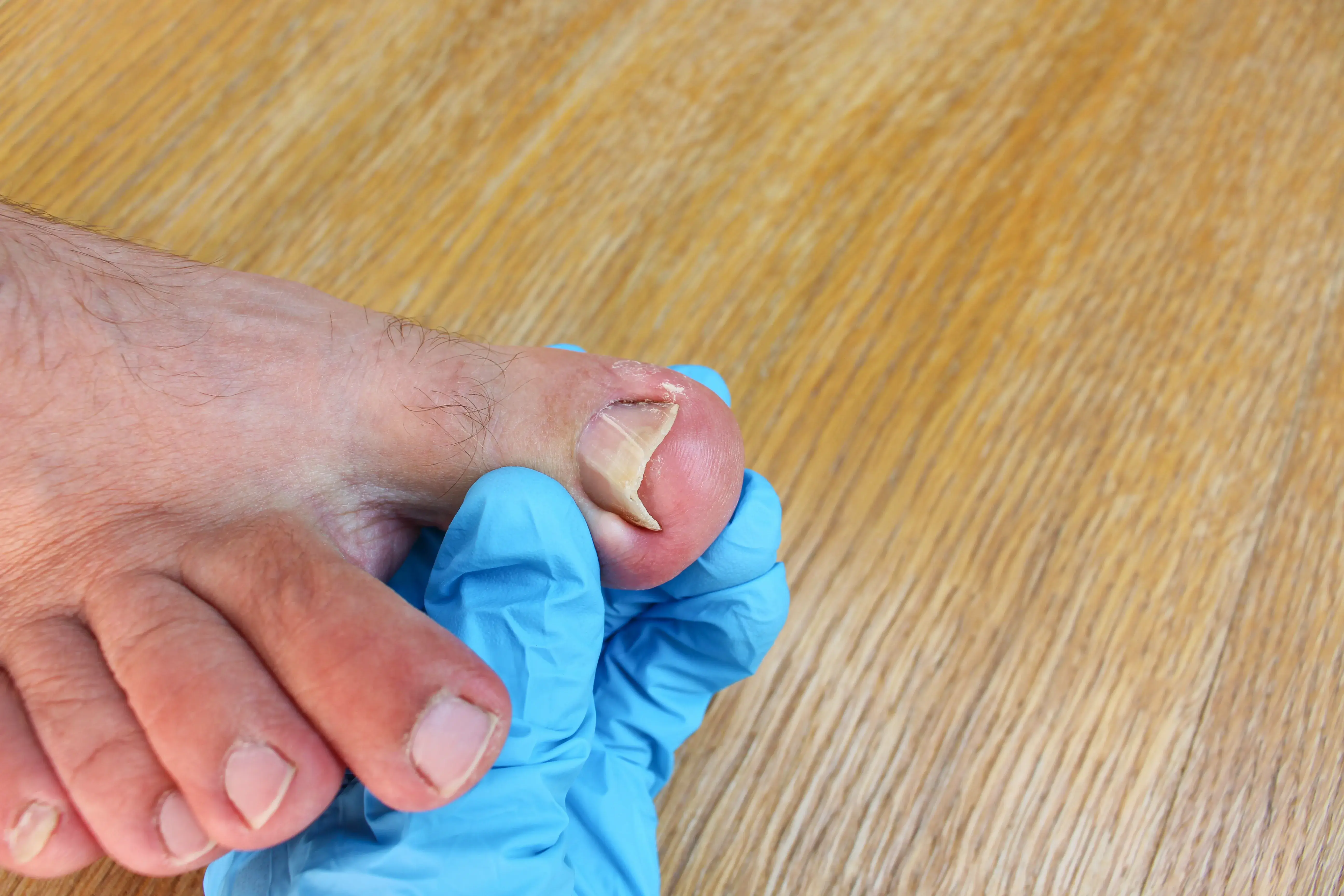Walking barefoot allows a person to go about on their own two feet. Because of the nails in front, the toe, which supports the femur and leg bones with joints and cartilage, is in continual touch with the outside world. Numerous factors may have an impact on them.
The main draw of the toenails is fungus and bacteria. The toenail's spongy layer of skin provides the microorganisms with a complete environment or home. Fungal toenail diseases are not as contagious as colds, and people transmit them in certain conditions. And the costs for transmission are huge as the condition can never disappear within days.
In this blog, we dive into this question by covering the "is Toenail fungus contagious" symptoms and causes of fungal nail infections and Toenail fungus prevention.
 Yes. However, toenail fungus seldom spreads beyond the toe. Some dermatophyte fungi are easily transmitted through your skin. Ringworm is a disorder that occurs when dermatophyte fungus infects your skin.
Toenail Fungus can sometimes spread to other body parts, including :
Yes. However, toenail fungus seldom spreads beyond the toe. Some dermatophyte fungi are easily transmitted through your skin. Ringworm is a disorder that occurs when dermatophyte fungus infects your skin.
Toenail Fungus can sometimes spread to other body parts, including :
Is toenail fungus infectious?
As a result, bacterial and fungal diseases can spread quickly. So for the question, Is toenail fungus contagious, the answer is yes. The fungus can flourish in environments where people wear slippers, go around barefoot, and have their feet covered in muck.- Mold growth is frequently facilitated when fungi attack toenails, fingers, the back of the ears, and dry scalp. This coating of damp sponginess provides the fungus with an alluring view. Both have a wet disposition, which creates a cozy connection that allows information to be shared.
- Fungus thrives in the warm, frequently damp environment of the toes. Certain fungi and occasionally yeast impact various nail components.
- If an infection is still not treated, it may spread to your skin, other toenails, or even your toenails. When fungi grow between the toenail and the nail bed, toenail fungus develops a split or laceration in your toe is typically when this happens.
Is it possible for toenail fungus to spread to other body parts?
 Yes. However, toenail fungus seldom spreads beyond the toe. Some dermatophyte fungi are easily transmitted through your skin. Ringworm is a disorder that occurs when dermatophyte fungus infects your skin.
Toenail Fungus can sometimes spread to other body parts, including :
Yes. However, toenail fungus seldom spreads beyond the toe. Some dermatophyte fungi are easily transmitted through your skin. Ringworm is a disorder that occurs when dermatophyte fungus infects your skin.
Toenail Fungus can sometimes spread to other body parts, including :
- Different toenails.
- The skin between your toes
- groin region
- Scalp (skin on top of your head).
What are the symptoms of Toenail Fungus?
Sometimes the circumstances, polluted surfaces, tainted soil, or diseased animals can spread disease-causing fungi to humans. Let us discuss symptoms of toenail fungal infection -#1. Redness
- Given that it is a fungus infection, the fundamental rule of any microbiological attack is that the rubor, or redness, is always the initial sign.
- Fungus grows on the toenail and develops an inborn impersonal system that elevates the blood vessels, resulting in rapid blood flow. Reddish skin is the appearance as a result of this.
#2. Inflammation
- White blood cells (WBCs) that are contagious migrate to the injured area due to toenail fungus, causing swelling and inflammation of the skin beneath the toenail. This phrase refers to a tumor or grouping of unwelcome cells.
- Walking becomes challenging in this circumstance due to fungal activity, especially on the toenails.
#3. Crack skin
- The fungus starts to bleach the skin when it gets settled properly. Immunity of the skin gets affected during bacterial or fungal actions. Mainly melanocytes are associated with it.
- A split or cracked skin is the first sign of a cutaneous toenail contagious. Crack skin frequently produces redness and excruciating itching. In some instances, the infection might end in painful, cracked skin.
- There may additionally be bumps and blisters. So, a crack skin is the morphological feature of a toenail fungal reaction.
What are the possible causes of toenail fungus?
Here are the causes of toenail fungal attacks -- The environment is hostile, especially when it is raining.
- Many fungi roam the surroundings during the monsoon season, from nooks and crannies to broad surfaces.
- The human becomes the host, and the fungus becomes the enjoyer whenever the skin of the toenail comes into contact with the sources of the infection.
- People who wear slippers are more susceptible to this illness.
- The likelihood of toenail fungus being contagious is significantly higher if the person is working in an unclean, toxic sewage environment.
- Working in an unclean, toxic sewage environment can significantly increase the chances of contagious toenail fungus.
- People of all ages and cultures wear slippers, but they are unsuitable for anyone with foot health issues or problems.
- Dusty environment
- The mite's digestive system cannot destroy fungal germs, so future generations may live after eating, provided they are given the proper nutrition from the human body.
- The fungus consumes dust, the mite eats the fungus, and the fungus survives digestion to consume additional dust.
- The loop is self-sustaining; the fungus consumes dust, the mite consumes the fungus, and the fungus survives digestion to consume additional dust and become mite food.
- Diabetes
- Chronic diabetes impairs the body's capacity to metabolize glucose (sugar), which results in dangerously high blood sugar levels. Scientists and scholars have linked diabetes-related elevated blood sugar levels and fungal infections.
- Because type 2 diabetics typically have higher blood sugar levels that disturb the average balance of fungus in the toenail, they may be even more prone to developing contagious and contaminating bacterial infections.
- Athletes foot
- Most cases of athlete's foot are brought on by a variety of fungus that is all members of the dermatophyte family and is also responsible for jock itch and ringworm.
- The fungi feed on keratin, a protein in hair, nails, and skin, and they flourish in enclosed, warm, wet settings. Rarely, non-dermatophytes like yeast can cause athlete's foot (candida).
- Toenail fungus can spread in athlete's feet is minimal. Direct touch with the virus and skin flakes left on towels, shoes, or floors might spread it. The likelihood of getting an athlete's foot may increase if you walk barefoot.
- The predisposition to developing an athlete's foot can also influence risk. For instance, people with diabetes or weakened immune systems are more likely to contract an infection if they have an open wound.
What are the Tips for Preventing the Spread of Toenail Fungus -
- Put on clean, dry shoes whenever you leave the house.
- Clean your shoes or footwear regularly to prevent dirt and debris from getting inside.
- Regular cleaning of your shoes will help them last longer. If you have allergies, anti-dust allergy shoes might be a good option.
- Exercise caution around animals and be sure your pet's vaccinations are up to date.
- Avoid sharing exercise equipment like ellipticals and treadmills with other people.
- Avoid Close contact with people who are sick.
- Stay away from heavily crowded areas like airports, cruise terminals, and public transportation.
- Cover your feet in high-traffic areas
Final Thoughts -
Since toenail fungus is contagious, it can range in severity from minor to dangerous. It implies that individuals should take good care of their bodies wherever they go. Although the situation is always challenging, taking the right steps can assist in preventing fungal infection. Ayurvedic, herbal, and even allopathic remedies are all accessible. Toenail dryness and dampness frequently cause bacterial and fungal development. People with diabetes should take much better care of themselves because they are more susceptible to the disease. This also applies to those who have athlete's feet. Just be careful and take good care of your entire body. I hope you enjoy it!!
Categorized into
General Health

Reviewed by







